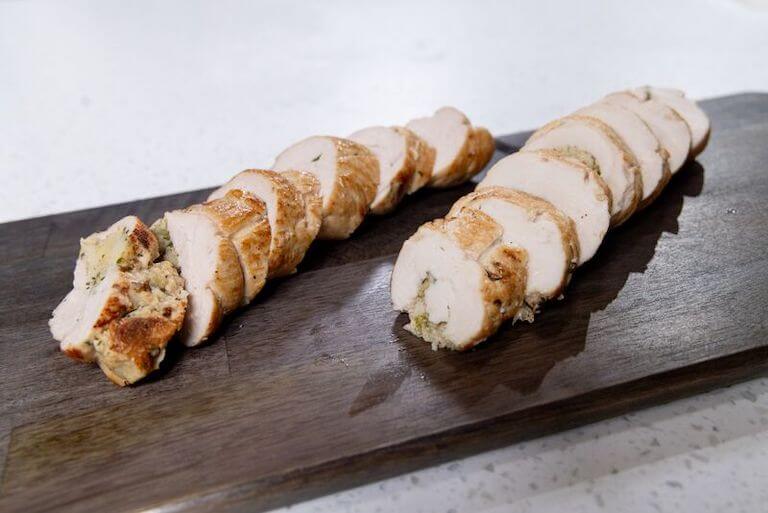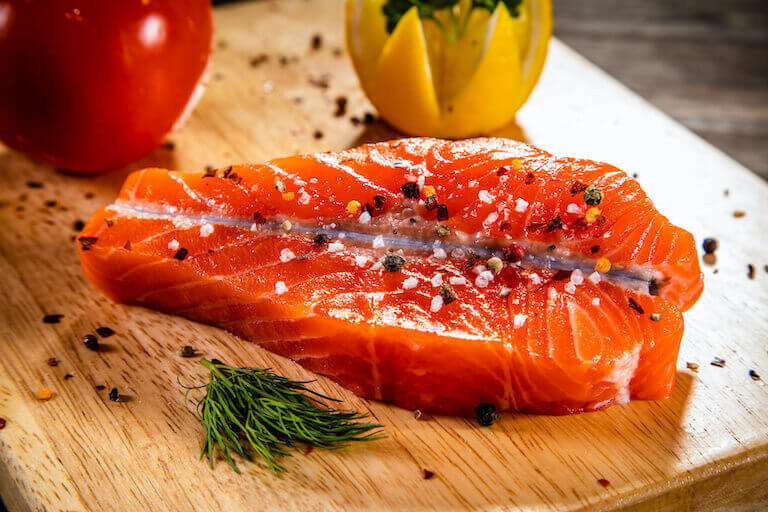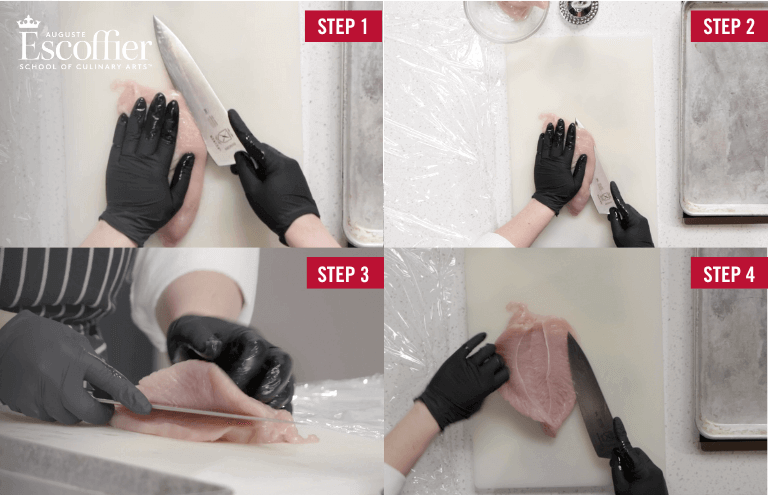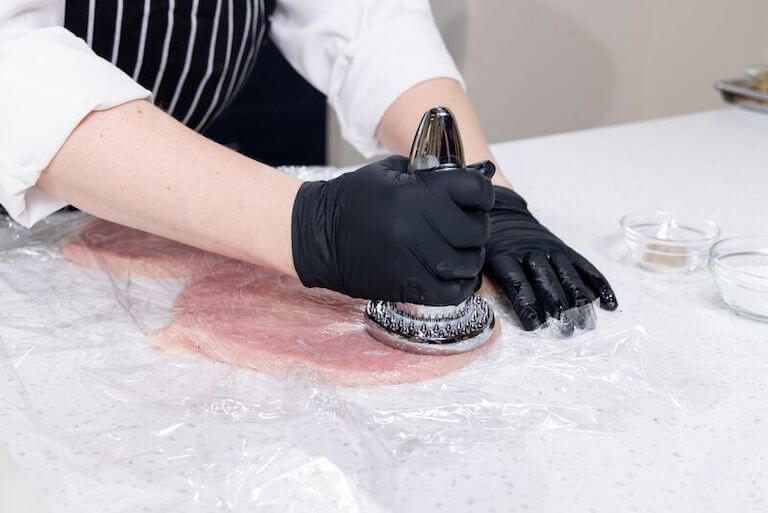Listen to This Article:
Have you ever marveled at the aesthetics and flavors of a meticulously rolled meat dish like a braciole, wondering how the stuffing of breadcrumbs, seasonings, and cheese comes together so wonderfully? Or pondered how a chef managed to roll chicken around ham and cheese to create chicken cordon bleu when the chicken breasts you’ve brought home are so plump it would take all day to pound them thin enough for such things?
Credit the butterfly cut, a technique that allows chefs to slice meat and poultry into thinner pieces in preparation for any number of dishes. It’s a cut you might have been using at home all along and never realized it had a name.
Butterfly cutting can help you prepare meat, poultry, and even fish to be stuffed or to create delightfully thin slices that better soak up marinades. Read on to discover more about this versatile and surprisingly straightforward technique.
What Is a Butterfly Cut?
A butterfly cut is made when you use your knife to cut food down the center but not all the way through, then spread the piece of meat, chicken, or fish open like you’re turning the page of a book. When laid out on a cutting board this way, the meat or chicken often resembles butterfly wings.
This technique is sometimes mistakenly called a spatchcock, but a spatchcock is done with a whole chicken instead of parts; you’d remove the backbone and then break the breastbone in order to lay the chicken or other poultry flat. Both techniques alter protein for faster cooking or certain cooking styles, but they are different.
A butterfly cut is used with meat, chicken, pork, or even different types of fish, including shrimp. You’ll see it used in recipes for everything from turkey roulade to stuffed pork. (A roulade is basically any dish made into a roll, including savory dishes with meats and stuffings or sweet desserts made with sponge cake and filling.)

Roulade is a type of dish that wraps a thin slice of meat, poultry, or fish around a filling.
Why Butterfly Cutting Is Important
The butterfly cut results in thinner cuts that can be easier to handle and can help elevate the taste of a dish.
Butterfly cutting can also help with faster and more even cooking. If you’ve ever tried to bake a chicken breast that was a couple of inches thick on one edge and a half-inch on the other, you’ll understand its usefulness. This can also be a food safety issue, ensuring that a cut is cooked to temperature all the way through.
You might use a butterfly cut as a first step to pounding a chicken breast or cut of meat even thinner, whether for rolling or thin cutlets. And a thinner piece of meat, chicken, or fish more readily soaks up marinade.

A butterfly cut is useful for meats, poultry, and even fish
Dishes That Use a Butterfly Cut
The butterfly cut is useful for creating thinner cuts that can be used in rollups or dishes that need to soak up marinades. These can include meals like:
- Chicken cordon bleu
- Meat rollups
- Butterflied shrimp
- Butterflied steak, seasoned and marinated
- Veal cutlets, stuffed with cheese and seasonings and pan fried
How to Make a Butterfly Cut
A butterfly cut is relatively easy, with only a few steps:

Butterfly cuts can be relatively easy to perform if you know the steps and take your time.
Step 1. First, lay the meat or poultry on a cutting board. If there’s skin on the chicken, remove it completely.
Step 2. If the protein is oblong (like a chicken breast or steak), lay it so that the short end is facing toward you. If you’re right-handed, the thickest side will face your right hand; and if you’re left-handed, the thickest side will face your left hand.
Step 3. Gently press the protein with the palm of your hand, slightly elevating your fingers so they are out of the way of the knife. Using a chef’s knife or boning knife, cut horizontally through the middle of the protein, parallel to the board, about 90% of the way through—leaving enough meat connected so that it’s still one piece.
Step 4. Open up the meat (or chicken, pork, fish) and lay it flat. If you plan to pound it thinner, place plastic wrap on top first, then pound from the center out until you reach the desired thickness . . . or thinness.
Remember, this isn’t a time for speed. Make sure to work methodically so you don’t cut your fingers. Slow down even further as you near the other end of the meat; as you don’t want to cut all the way through. There you have it – a successful butterfly cut!

The butterfly cut helps chefs create thinner slices of meat
Mistakes to Avoid When Butterfly Cutting
Although the butterfly cut is a pretty straightforward technique, it’s possible to make mistakes.
Remember that the whole point is to slice the item in half to produce something with even thickness. So one mistake would be to make an uneven cut, missing the midway point.
You also want the right tool for the job and one that’s in good shape. Avoid using a dull knife, which can lead you to use a sawing motion that can tear at the ingredient. Dull knives can also be dangerous because you’re forced to use extra force, and one slip can result in an injury.
Make sure to use the right knife for the job. Generally, a chef’s knife or boning knife is good fur butterfly cuts; each is versatile with good heft. In contrast, a serrated knife would produce too much of a tear.
And finally, one more reminder to take your time. Although you might chop and dice at a sprint, the butterfly cut is one place to let off the gas a little. Not only do you want to make the cut at the right spot, but you want to stop before cutting all the way through, and your fingers are a little more vulnerable because of the angle of the knife.
Discover More Techniques Like the Butterfly Cut at Escoffier
Whether you’re grilling a steak to perfection or wondering how to prepare a chicken breast that’s uneven in shape, the butterfly cut can take your cooking to another level. Though fairly simple to learn, the technique is not always obvious and is one that can distinguish a professional dish from an amateur’s.
To find out more about expertly preparing food like a pro, check out Auguste Escoffier’s Culinary Arts programs, where students can expand upon their culinary foundations, discover business skills, and explore cuisines from around the world.



